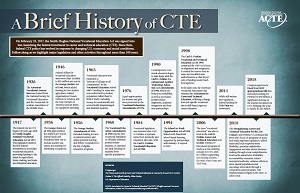History of CTE
HISTORY OF CTE
Career and technical education as we know it today has its roots in the founding of the United States. From the start, a strong knowledge base and skill set for citizens were considered important. The following four articles from the old AVA Journal in 1976 show how career and technical education has adapted over time to stay at the forefront of American society. In addition, you can learn about the first century of federal investment in CTE with the following timeline.
The Awakening, 1776-1826
The right to a free public education for children was stressed early in the United States as there was a need to educate future leaders. Apprenticeships were giving way to formal schooling in certain trades. During the first 50 years of the United States, public education was largely limited to boys, although in the early-1800s, girls began to enter schools to prepare for teaching.
Learn More linkIndependent Action, 1826-1876
In the early 19th century, the workforce and the public education system started to work together to create a continuous stream of workers for different jobs. Schools specializing in training students to enter a certain area of the workforce started to open their doors, creating the basic framework for career and technical education. The idea started to spread to women’s colleges in the 1840s. The beginning of public high schools is explored to continue to educate citizens.
Learn More linkThe Vocational Education Age Emerges, 1876-1926
The first manual training school, established in St. Louis, Missouri, in 1879, set the foundation for modern career and technical education. The school combined hands-on learning with classroom learning. The article describes the first trade school, which opened in New York in 1881. Near the turn of the 20th century, agricultural education started to thrive with agriculture schools starting to open their doors. Bills passed to support career and technical education are explored.
Learn More linkComing of Age, 1926-1976
The first mass acceptance of career and technical education came after World War I and the movement spread in the years that followed. Career and technical education expanded to include adult education and retraining citizens to re-enter the workforce. World War II caused a surge in career and technical education as technical skills were needed for defense purposes.
Learn More link






